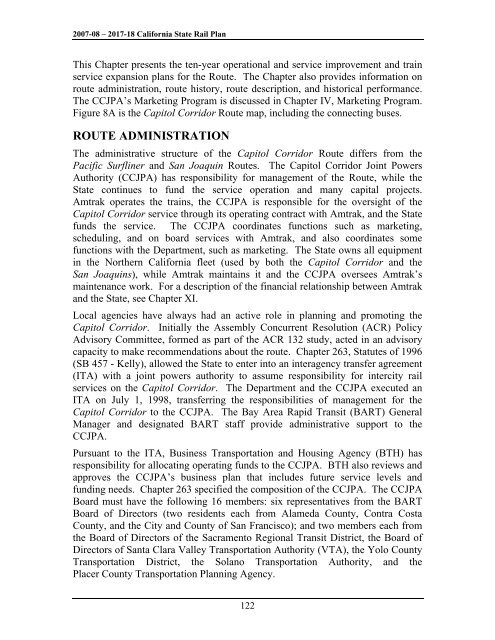California State Rail Plan 2007-08 to 2017-18
California State Rail Plan 2007-08 to 2017-18
California State Rail Plan 2007-08 to 2017-18
- No tags were found...
You also want an ePaper? Increase the reach of your titles
YUMPU automatically turns print PDFs into web optimized ePapers that Google loves.
<strong>2007</strong>-<strong>08</strong> – <strong>2017</strong>-<strong>18</strong> <strong>California</strong> <strong>State</strong> <strong>Rail</strong> <strong>Plan</strong>This Chapter presents the ten-year operational and service improvement and trainservice expansion plans for the Route. The Chapter also provides information onroute administration, route his<strong>to</strong>ry, route description, and his<strong>to</strong>rical performance.The CCJPA’s Marketing Program is discussed in Chapter IV, Marketing Program.Figure 8A is the Capi<strong>to</strong>l Corridor Route map, including the connecting buses.ROUTE ADMINISTRATIONThe administrative structure of the Capi<strong>to</strong>l Corridor Route differs from thePacific Surfliner and San Joaquin Routes. The Capi<strong>to</strong>l Corridor Joint PowersAuthority (CCJPA) has responsibility for management of the Route, while the<strong>State</strong> continues <strong>to</strong> fund the service operation and many capital projects.Amtrak operates the trains, the CCJPA is responsible for the oversight of theCapi<strong>to</strong>l Corridor service through its operating contract with Amtrak, and the <strong>State</strong>funds the service. The CCJPA coordinates functions such as marketing,scheduling, and on board services with Amtrak, and also coordinates somefunctions with the Department, such as marketing. The <strong>State</strong> owns all equipmentin the Northern <strong>California</strong> fleet (used by both the Capi<strong>to</strong>l Corridor and theSan Joaquins), while Amtrak maintains it and the CCJPA oversees Amtrak’smaintenance work. For a description of the financial relationship between Amtrakand the <strong>State</strong>, see Chapter XI.Local agencies have always had an active role in planning and promoting theCapi<strong>to</strong>l Corridor. Initially the Assembly Concurrent Resolution (ACR) PolicyAdvisory Committee, formed as part of the ACR 132 study, acted in an advisorycapacity <strong>to</strong> make recommendations about the route. Chapter 263, Statutes of 1996(SB 457 - Kelly), allowed the <strong>State</strong> <strong>to</strong> enter in<strong>to</strong> an interagency transfer agreement(ITA) with a joint powers authority <strong>to</strong> assume responsibility for intercity railservices on the Capi<strong>to</strong>l Corridor. The Department and the CCJPA executed anITA on July 1, 1998, transferring the responsibilities of management for theCapi<strong>to</strong>l Corridor <strong>to</strong> the CCJPA. The Bay Area Rapid Transit (BART) GeneralManager and designated BART staff provide administrative support <strong>to</strong> theCCJPA.Pursuant <strong>to</strong> the ITA, Business Transportation and Housing Agency (BTH) hasresponsibility for allocating operating funds <strong>to</strong> the CCJPA. BTH also reviews andapproves the CCJPA’s business plan that includes future service levels andfunding needs. Chapter 263 specified the composition of the CCJPA. The CCJPABoard must have the following 16 members: six representatives from the BARTBoard of Direc<strong>to</strong>rs (two residents each from Alameda County, Contra CostaCounty, and the City and County of San Francisco); and two members each fromthe Board of Direc<strong>to</strong>rs of the Sacramen<strong>to</strong> Regional Transit District, the Board ofDirec<strong>to</strong>rs of Santa Clara Valley Transportation Authority (VTA), the Yolo CountyTransportation District, the Solano Transportation Authority, and thePlacer County Transportation <strong>Plan</strong>ning Agency.122













